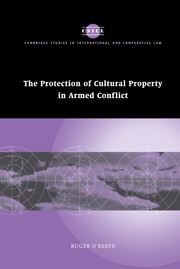Book contents
- Frontmatter
- Contents
- Acknowledgements
- Table of cases
- Table of treaties and other international instruments
- List of abbreviations
- Prologue
- 1 From the high Renaissance to the Hague Rules
- 2 1914 to 1954
- 3 The 1954 Hague Convention and First Hague Protocol
- 4 The 1977 Additional Protocols
- 5 The 1999 Second Hague Protocol
- 6 Other relevant bodies of law
- Epilogue
- Bibliography
- Index
- CAMBRIDGE STUDIES IN INTERNATIONAL AND COMPARATIVE LAW
1 - From the high Renaissance to the Hague Rules
Published online by Cambridge University Press: 28 July 2009
- Frontmatter
- Contents
- Acknowledgements
- Table of cases
- Table of treaties and other international instruments
- List of abbreviations
- Prologue
- 1 From the high Renaissance to the Hague Rules
- 2 1914 to 1954
- 3 The 1954 Hague Convention and First Hague Protocol
- 4 The 1977 Additional Protocols
- 5 The 1999 Second Hague Protocol
- 6 Other relevant bodies of law
- Epilogue
- Bibliography
- Index
- CAMBRIDGE STUDIES IN INTERNATIONAL AND COMPARATIVE LAW
Summary
As early as the 1500s, moral theologians and writers on the law of nations were enunciating rules which sought to regulate both the destruction and the plunder of cultural property in war. The same period also saw the birth of the metaphysical vision of such property as a universal estate, later to be termed a ‘heritage’, common to all peoples, a vision sometimes ad idem and sometimes at odds with the international legal position. Modified in the wake of the Napoleonic Wars and challenged by the technological and strategic revolutions of the nineteenth century, the customary international rules regulating the wartime treatment of cultural property came to be codified in the 1907 Hague Rules, which aimed to temper the conduct of war on land.
The classical law
As conceived in the sixteenth and seventeenth centuries, the rationale of the laws governing the conduct of hostilities was to minimise the harm inflicted in a sovereign's exercise of his right to wage just war. The balance of evil and good was sought to be struck by reference to the doctrine of necessity. It was held to be a ‘general rule from the law of nature’ that as long as the end pursued by the war was just, armed violence necessary to achieve that end, including destruction of enemy property, was permissible.
- Type
- Chapter
- Information
- Publisher: Cambridge University PressPrint publication year: 2006

